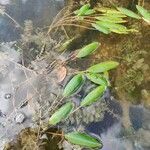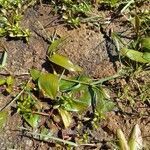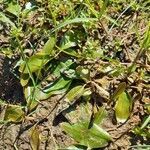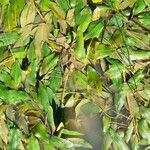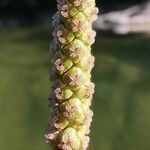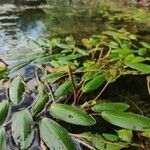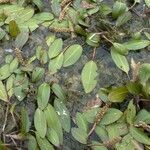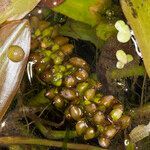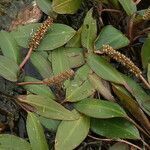Floating leaves usually present, always in flowering or fruiting adult plants (sometimes absent in adult fertile plants growing in strongly flowing water, but we have not seen such specimens from Africa); lamina coriaceous, light green, opaque, often with a reddish tinge, sometimes brownish or rarely secondarily blackish (when dried slowly), narrowly oblong to broadly elliptical, mostly narrowly to broadly cuneate and narrowed towards the petiole, but sometimes even rounded at base, particularly in standing water; petiole often narrowly winged towards the lamina, never with a discoloured section. Submerged leaves usually present, well developed and preserved in running water, but sometimes decaying in shallow standing water, petiolate; lamina membraneous, narrowly oblong to oblanceolate-oblong, never reduced to phyllodes, light green to reddish brown, usually 11-15-veined in fully developed upper leaves, lower leaves with fewer veins, gradually narrowed towards a narrowly obtuse or subacute apex, often broadly obtuse in leaves from the basal parts of the stem, never mucronate; petiole mostly more than 3 cm long, often even longer than 10 cm in running water, but can sometimes be very short in standing water, 0.2-2 times as long as the lamina. Stipules widest near the base and gradually narrowing to their apex, often quickly decaying and gradually disappearing. Peduncles as thick as or sometimes slightly thicker than the stem. Fruits 3.0-3.9(-4.0) mm long, reddish brown or sometimes reddish green, with + obtuse and low dorsal keel.
Perennial with rhizomes much ramified, matted, woody, usually orange-brown, terete, with the internodes up to 8 cm long; scaly winterbuds formed in autumn. Stems erect, usually unbranched, up to 100 cm long. Leaves with submerged and floating forms or, if on land, with aerial blades; in deep water the submerged (juvenile) leaves decay before or during flowering; all the leaves petioled, the length varying with the depth of the water; lamina of the submerged leaves linear to linear-lanceolate, tapering to the base and apex, 8-20 cm long and 8-16 mm broad, thin, net-veined, with the transverse veins oblique, ascending; floating lamina elliptic to ovate, obtuse to rounded at the base, apex rounded to acute, about 5 cm long and 2.5 cm broad (up to 8 x 3.5 cm) coriaceous, veins indistinct; intermediate forms between the submerged and floating forms occur; leaves of land forms usually smaller, midrib prominent below; stipules folded, membranous, lower amplexicaul, upper spreading, ovate, acuminate, variable in size, up to 6 cm long. Spikes on somewhat swollen arcuate scapes, 5-10 cm long, flowering part cylindrical up to 5 cm long in fruit, many flowered. Drupe rounded, compressed c. 4 mm long, green to brown, the convex dorsal side 3-carinate, the keels terminating in 3 basal knobs, sides loping inwards to a ventral keel which is indented or straight.
Rhizomes present. Cauline stems terete, without spots, to 100 cm; nodal glands absent. Turions absent. Leaves both submersed and floating, or floating absent, ± spirally arranged. Submersed leaves petiolate, lax; stipules persistent to deliquescent, conspicuous, convolute, free from blade, light brown, not ligulate, 3--9 cm, not fibrous, not shredding at tip, apex round to acute; petioles 2--13 cm; blade light to dark green, linear-lanceolate to lance-elliptic, not arcuate, 9--20 cm ´ 10--35 mm, base acute, without basal lobes, not clasping, margins entire, not crispate, apex not hoodlike, acute, without sharp awl-like tip, lacunae in 2--5 rows each side of midrib; veins 7--15. Floating leaves: petioles 3.5--26 cm; blade adaxially light green, lenticular to elliptic, 3--11 cm ´ 15--45 mm, base cuneate to rounded, apex acute to rounded; veins 9--21. Inflorescences unbranched, emersed; peduncles not dimorphic, terminal, erect to ascending, cylindric, 3--15 cm; spikes not dimorphic, cylindric, 20--70 mm. Fruits sessile, red to reddish brown, obovoid, abaxially keeled, laterally ridged, 2.7--4.3 ´ 2.5--3 mm, keel well developed, lateral ridges with blunt to sharp tips; beak erect; sides without basal tubercles; embryo with 1 full spiral. 2n = 52.
Vertical shoots short-lived or annual, seasonal; stem slender to robust, terete, to 2 m long, mostly unbranched; horizontal shoots robust, long-creeping, biennial or perennial, much branched, producing dormant apical multiple winter buds. Submerged leaves lanceolate to oblong-lanceolate, petiolate, often absent after fructification, lamina 50-280 by 10-40(-50) mm, 11-21-veined, margin denticulate, at least when young, base cuneate, apex rounded to acute; petioles 30-150 mm; floating leaves lanceolate-elliptical to obovoid, petiolate, lamina 50-150 by 20-50 mm, 11-23-veined, base cuneate, apex acute, petioles 100-250 mm, longer than lamina; stipules axillary, convolute, 20-60 mm, inconspicuously 2-keeled. Spike cylindrical, contiguous, 20-50 mm; peduncle 40-130 mm, slightly thickened. Flowers numerous, with (3-)4 carpels. Fruits variable in shape and colour, 2.7-4.1 mm long, dorsally and ventrally keeled, sometimes carinate. Stem anatomy: Stele of trio or proto type. Endodermis of O-type. Interlacunar bundles absent, rarely a few in the outer ring; subepidermal bundles absent. Pseudo-hypodermis absent. Chromosome number: 2n = 52.
Stem branched, to 2 m; submersed lvs thin, narrowly lanceolate to linear, to 3 dm, 1–2.5(–3) cm wide, 7–15-veined, acute, usually with a pair of conspicuous lacunar bands along the midvein, gradually tapering into a long (2–13 cm) petiole; floating lvs elliptic, 5–13 × 1–4 cm, acute or acutish, on petioles 5–20 cm; stipules axillary, free, 4–10 cm, attenuate to obtuse; peduncles 5–12 cm, stout, often thicker than the stem; spikes dense, cylindric, 3–5 cm; frs broadly semi-obovoid, 3–4 mm (including the short beak), with a sharp, narrow, often tuberculate dorsal keel sometimes flanked by 2 low ridges. Variously slow or fast, deep or shallow, often alkaline water; nearly cosmopolitan, and throughout our range. (P. americanus; ? P. fluitans)
Perennial herb, hydrophyte, height depending on depth of water; rhizomes ramified, woody, usually orange-brown, terete; stems erect, usually simple. Leaves either submerged or floating or aerial in terrestrial plants; petioled, length varying with depth of water; submerged lamina linear to linear-lanceolate, tapering at base and apex; floating lamina elliptic to ovate, obtuse to rounded at base, apices rounded to acute; aerial leaves with midrib prominent below. Scape arcuate, swollen. Spikes 50-100 mm long, cylindrical, many-flowered. Flowering time Jan., Feb. Fruit a rounded drupe, compressed, green to brown, convex side 3-carinate, keels terminating in 3 basal knobs, sides looping inwards to ventral keel which is indented or straight.
Plants perennial, in fresh water. Rhizome terete, slender to robust. Stems usually simple or occasionally sparsely branched, terete, 1.5-2 mm in diam. Leaves dimorphic; stipules axillary, convolute, 2-4 cm, membranous, amplexicaul. Submerged leaves petiolate; petiole 0.2-1.5 × length of blade; blade lanceolate or narrowly lanceolate, (7-)11-21-veined, apex obtuse, often decaying early. Floating leaves opaque; blade elliptic or ovate-elliptic, 3-6 × 1.5-3 cm, leathery, (11-)15-23-veined, base cuneate or obtuse, apex acute or slightly obtuse. Spikes cylindric, densely flowered; peduncles 4-6 cm, thicker than stem. Carpels 4. Fruit obovoid, 3-4 mm, abaxial keel distinct. Fl. and fr. Jul-Sep. 2n = 52.
Perennial, aquatic herb, up to 1 m high. Leaves submerged ones persistent, usually also floating ones without a discoloured section at junction of petiole and blade, all with petioles; blade elliptic to oblong-ovate, margins smooth, veining indistinct, leathery. Flowers: in many-flowered spikes; Nov.-Mar. Fruit 3-4 mm long.
Perennial herb, up to 1 m high. Primary submerged leaves if in deep water soon disintegrating; mature leaves floating, with an elliptic to ovate, coriaceous lamina, margin smooth, veining indistinct. Flowers green.
Aquatic forming large mats. Leaves submerged and floating, petiolate, floating blades ovate. Flowers on slightly swollen peduncles, inconspicuous.
